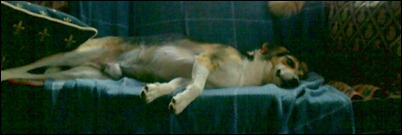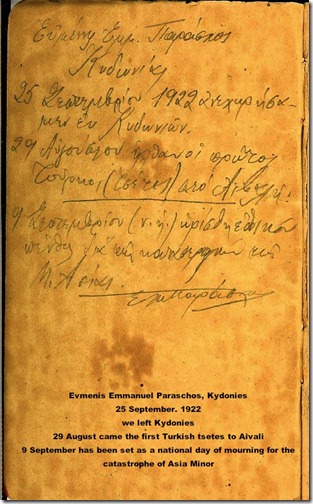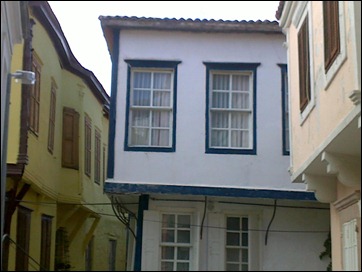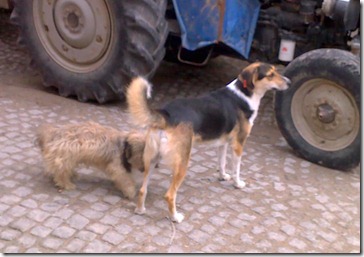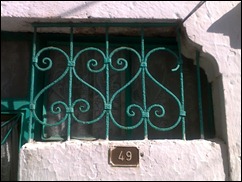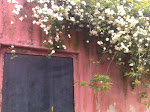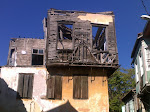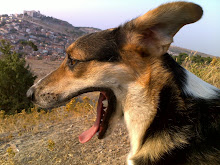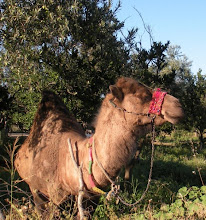To new readers: this is the third post in a series about the search for a lost house in Ayvalik. In order to follow the narrative, it would be best to start by reading Part I and Part II.
September is a beautiful month in Ayvalik. Every year, at some time during the first two weeks of the month, the temperature drops suddenly: overnight, the searing summer heat of the Aegean disappears and is replaced by soft sunny days, cooled by breezes off the sea, as the town relaxes into a quiet golden autumn, with the tourists mostly gone and the children back at school. Should you ever wish to visit Ayvalik, September is a very good time to come.
When I imagine September, 1922 in Ayvalik, I see the town bathed in that same soft sunlight, the breeze rustling through the pines, and the fear etched on the faces of its remaining Greek population, as they are finally forced to accept that the tsunami of the Asia Minor Catastrophe is not, as they had hoped and prayed, going to pass them by.
On the evening of the 24th September, 1922, Dr. Emmanouil Paraschos (pictured above with his family in a photograph taken earlier in 1922) who, like so many others, had been convinced that if the Greeks of Ayvalik stayed put, and stayed quiet, the war would wash harmlessly by them, came home from work in one of Ayvalik’s two hospitals and, deeply distressed and in tears, told his wife Vrysiis that there was no longer any choice in the matter: the time had come for them to leave.
The marauding bands of Turkish irregular soldiers - ‘Tsetes’, in Greek - who had been in the area since August, were now burning Greek villages just along the coast, and killing the inhabitants, he said; soon they would do the same in Ayvalik itself, if any of the Greek inhabitants remained. All able-bodied males over the age of 18 were to be rounded up and sent to labour camps in the Anatolian interior; only the old men, the sick, and women and children would be allowed to leave. There were Allied ships in the harbour waiting to take them into exile; they would sail the following morning.
Having told his wife, Dr Paraschos dried his tears and, with difficulty, pulled himself together in order to appear strong and calm whilst delivering this dreadful news to their five children: Athanasios, aged 18, Evmenis, 14, Polyxeni, 12, Kosta, 10, and Yannis, 2.
What was particularly painful for him was that whilst, as a prominent Ayvalik doctor with many influential Turkish friends, Emmanouil Paraschos had managed to gain an exemption from being sent to a labour camp, and was to be one of the few adult Greek men allowed to leave Ayvalik, he had been unable to obtain any such exemption for his 18 year old son, Athanasios. It was therefore decided that Athanasios would take the risk of going into hiding with Turkish friends, and try to escape to Mytilene later, rather than take the much greater risk of enduring a forced march into the Anatolian interior towards the grim privations of a labour camp.
The family spent the night making preparations to leave their home, possibly for ever. The first thing they did was to cover the windows with blankets, to ensure they could not be seen by any Tsetes who might be roaming the streets already. Then, they set about gathering together what little they could take with them. Vrysiis went to a cupboard and took out 5 blankets, giving one to each of the children. They would be able to take only what they could manage to carry on their backs, wrapped in a blanket.
When the children had sorted out a couple of changes of clothes each, a few toys and books, and their stamp collections, they were sent to bed. Then Vrysiis got down to work: she took out all her jewellery from the box in which it was stored and, through the hours of the night, carefully unpicked the seams of the coats of the family members, inserted all the pieces of jewellery, and then just as carefully sewed up the seams again so that the jewellery was invisible.
Once the jewellery was sewn up into the coats , and ready to be transported into exile safely hidden,Vrysiis got on with her next task: cleaning the house. It was a matter of honour to her that, whatever the circumstances of their departure, she could not leave behind a dirty house for others to find; so, as the children slept and the darkness of the night began to edge towards a grey dawn, Vrysiis swept, scrubbed and mopped.
Perhaps this mindless, physically demanding activity also helped her to endure the intense fear and anxiety of this terrible night, knowing that in the morning she, her husband and children would be forced not only to abandon their home and their lives in Ayvalik and sail away to a highly uncertain future, but also to leave behind the family’s eldest son, in a position of great danger. By the time the sun came up over the hills behind Ayvalik, and cast its rays over the Aegean towards Mytilene, the kitchen of the Paraschos house was immaculate, the tiled floor gleaming, all the utensils, ranged on their shelves, sparkling clean.
The next morning the Paraschos family, along with hundreds of others, all carrying similar small bundles of possessions, walked down to the harbour. There the boats were waiting to take them as refugees to the island which lies just offshore, and is clearly visible from Ayvalik: Mytilene, also known as Lesbos, once part of the Ottoman Empire, but by 1922 belonging to the Republic of Greece, and a safe haven for the Ayvalik Greeks.
Although the family were able to take some portable valuables – a small amount of money, jewellery, and a couple of stamp collections - with them into exile, they left behind virtually everything they owned: a fine, three storey house, one of the beautiful neo-classical stone mansions of Ayvalik, full of elegant furniture, rugs, china, art, and books; all the possessions of a well to do Asia Minor Greek professional family at the beginning of the 20th century. The Paraschos family would never be able to reclaim that house, or those possessions, but were fortunate in that they, unlike many others, escaped with their lives (Athanasios, with the help of Turkish friends, managed to escape to Mytilene and join the rest of the family a few days later).
Those lives would be eventually be remade and lived out successfully in other countries – Greece and the United States – but the entire Paraschos family would always carry with them, and pass on to their children, and their grandchildren, the sadness of exile, of refugeedom, and the enduring memories of the beautiful house in Ayvalik that was once their family home, on the western shores of Asia Minor, the homeland of their ancestors.
And that lost house was the one I was now trying to find, so far unsuccessfully, on behalf of one of Dr Paraschos’ grandchildren, another Emmanouil (Manny). It happens very often in families that the younger generations fail to appreciate that their older relatives, keepers of the family memories and history, much of it never written down, will not be around for ever to answer questions, and thus it was with the Paraschos family: by the time Manny got round to wondering if it might be possible to find the lost family home, most of the family members who had ever been there were dead, and there were few clues left as to its exact whereabouts in Ayvalik.
What Manny did find, however, on searching through the papers of his father, Evmenis, the second son, who died in 1975, was several copies of a very small and very dark photograph of a house -
- and this is the photograph he emailed to me a few weeks ago, as a possible candidate for the Paraschos family house.
His father Evmenis had, in the early 1950s, been permitted to come back to Ayvalik from Greece for a short visit of a couple of days, and had walked the streets (all by then renamed, in Turkish) of the much changed town, looking for the house he had left as a child three decades earlier. This was not, it should be noted, in an attempt to reclaim the house from its new owners: under the terms of the Treaty of Lausanne, 1923, all those exiled from Turkey to Greece, and vice versa, in the Population Exchange forfeited not only the citizenship of the country they left, but all the property they were forced to leave behind there.
Manny thought that although the photograph of the house was unlabelled, his father must have taken it on this brief visit to Ayvalik. Further, as there were several copies, the photograph must be of some significance: it could well be the family home. This photo, this house, were all, for the moment, that we had to go on.
Could I find the house in the photograph for him?
You would have to be intimately familiar with the topography of Ayvalik, the old town spread across several hills sloping down to the Aegean, the warren of steep, narrow cobbled streets and tiny alleyways, the whole vast mélange of thousands of old buildings, in all possible states of repair and disrepair, from ‘a pile of stones’ and ‘ in ruins’, through ‘partially derelict’ and ‘in need of some urgent attention’, up to and including ‘modernised out of all recognition’, to understand quite how much my heart sank when I saw that photograph.
The photograph was so small and so dark that you couldn’t make out much detail, and since the house in the picture was of only one storey, it was clear that it must be one of the many larger houses in Ayvalik that had lost its upper storey, or storeys, in the major earthquake which hit the town in the 1940s. Along with the upper part of the house would have gone a lot of distinguishing detail: there are many once sizeable houses in Ayvalik with missing upper storeys and, to the casual glance at least, they all look rather alike.
I sat and stared at the photograph, rather dispiritedly. I imagined spending the next few weeks wandering the streets of Ayvalik, a print-out of the photo in hand, trying to find anything that resembled it. The old town of Ayvalik is BIG. It has a number of separate neigbourhoods, with some of which I am only passingly familiar. Although I’ve lived here for over two years, and walk around with my dog Freddie every day, I’m still constantly discovering streets and alleys which I have never ventured down – or, more likely, as the town is built on hills, up – before. I live in the lower part of the town, equidistant between the pine woods and the sea, but this house could be anywhere, if it still existed at all.
I continued to stare miserably at the photograph, beginning to regret that I had so blithely undertaken the task of finding the Paraschos house. Then I noticed something. On the left hand side of the photograph, on the opposite side of the narrow street from the house which might or might not be the Paraschos house, there was a house with a protruding window on the first (or for Americans, the second) floor, a common feature of Ottoman, and Ayvalik, architecture. What was unusual about it, though, was that the window looked very low, not more than 8 or 9 feet above the ground; generally, in this town of tall, thin 3 storey houses, they are much higher, as in the photograph below:
I vaguely remembered walking down a street with just such an unusually low protruding window, one low enough so that you could reach up and touch it, only a few days before - but where the hell had it been?
Then I remembered that I’d been in the street to photograph a horse and cart I spotted tied up there, and that the low protruding window had been somewhere beyond the horse and cart. Going into the photo files on the computer, I started to search and eventually found this embarrassingly incompetent photograph, with the light all haywire, which would never be seeing the light of day on this blog were it not an important step in the search for the Paraschos house:
However, my photographic deficiencies notwithstanding, if you look closely at the photograph you can see that behind the heap of tomatoes in the cart is a protruding window, not very high up, opposite which is a line of low one storey buildings.
Now go back and look at the photograph Manny sent me, of the house with a similar low protruding window opposite the one storey house, bearing in mind that the two photographs are taken from the opposite ends of their respective streets, one showing the window on the right, one on the left.
That night I looked at one photo, then the other, back and forth, over and over again. Could these two photographs, taken from different angles, be of one and the same street? Could I have already found the Paraschos house, without knowing it, on the day I had recently spent photographing horses and carts (still a common form of transport in Ayvalik)?
It certainly seemed possible, as there was clearly a striking similarity between the two streets pictured in the photographs, but the only way to tell would be to go and look at that street again, with a copy of the photograph Manny had sent me. I glanced at my watch. It was nearly midnight. I looked over at Freddie, who was stretched out on his blanket on his designated sofa, looking about as comfortable as it was possible for a dog to be:
Freddie did not look like a dog who wanted to go anywhere anytime soon.
Well, tough.
We were on a mission.
Perhaps not a Mission from God, but a mission, just the same.
‘C’mon Fred,’ I said briskly. ‘We’re going for a walk.’
(to be continued)
The image below shows the diary entry of Manny’s father, Evmenis Paraschos, then 14 years old, for 25th September, 1922, the day the family left Ayvalik (also known in Greek as Kidonies) to go into exile.
Many thanks to the Paraschos family for providing me with the images used above, and also for sharing their collective memories both of the family’s life in Ayvalik and their experience of becoming refugees, on which much of this post was based.
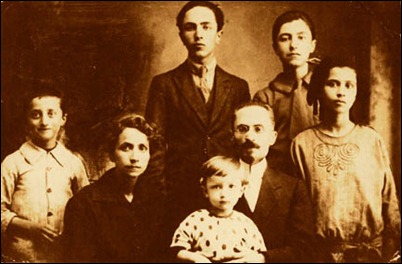
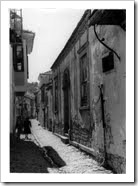
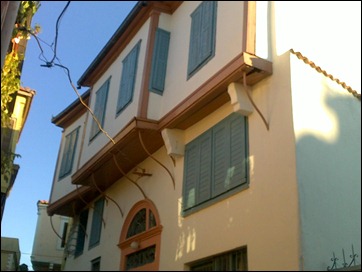
![240820104678[1] 240820104678[1]](http://lh5.ggpht.com/_ZDfm7EUoodI/TLtxd3J2OzI/AAAAAAAAAa0/xjU5ob3MUzg/240820104678%5B1%5D_thumb%5B4%5D.jpg?imgmax=800)
